
The Basset Hound is a short-legged breed of dog in the hound family. The Basset is a scent hound that was originally bred for the purpose of hunting hare. Their sense of smell and ability to ground-scent is second only to the Bloodhound.

Scent hounds are a type of hound that primarily hunts by scent rather than sight. These breeds are hunting dogs and are generally regarded as having some of the most sensitive noses among dogs. Scent hounds specialize in following scent or smells. Most of them tend to have long, drooping ears and large nasal cavities to enhance smell sensitivity. They need to have relatively high endurance to be able to keep track of scent over long distances and rough terrain. It is believed that they were first bred by the Celts by crossbreeding mastiff-type dogs with sighthounds. The first established scent hounds were St. Hubert Hounds bred by monks in Belgium during the Middle Ages.

The Black and Tan Coonhound is a breed of hunting dog. Developed in the United States from crosses between the Bloodhound and the Black and Tan Virginia Foxhound, this scent hound runs its game entirely by scent and is used primarily for raccoon hunting.

A hunting dog is a canine that hunts with or for hunters. There are several different types of hunting dog developed for various tasks and purposes. The major categories of hunting dog include hounds, terriers, cur type dogs, and gun dogs. Further distinctions within these categories can be made, based upon the dog's skills and capabilities. They are usually larger and have a more sensitive smell than normal dogs.

Coursing by humans is the pursuit of game or other animals by dogs—chiefly greyhounds and other sighthounds—catching their prey by speed, running by sight, but not by scent. Coursing was a common hunting technique, practised by the nobility, the landed and wealthy, as well as by commoners with sighthounds and lurchers. In its oldest recorded form in the Western world, as described by Arrian—it was a sport practised by all levels of society, and it remained the case until Carolingian period forest law appropriated hunting grounds, or commons, for the king, the nobility, and other landowners. It then became a formalised competition, specifically on hare in Britain, practised under rules, the Laws of the Leash'.
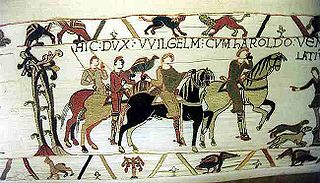
Royal hunting, also royal art of hunting, was a hunting practice of the aristocracy throughout the known world in the Middle Ages, from Europe to Far East. While humans hunted wild animals since time immemorial, and all classes engaged in hunting as an important source of food and at times the principal source of nutrition, the necessity of hunting was transformed into a stylized pastime of the aristocracy. In Europe in the High Middle Ages the practice was widespread.
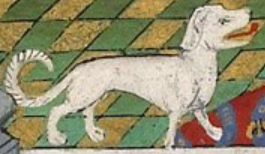
The Talbot was a type of hunting hound common in England during the Middle Ages. It is depicted in art of the period as small to medium-sized, white in colour, with short legs, large powerful feet, a deep chest with a slender waist, long drooping ears, and a very long curled tail. It is shown in one well-known example at Haddon Hall with a fierce facial expression. It is now extinct, but is believed to be an ancestor of the modern Beagle and Bloodhound. It is uncertain whether it was a scenthound, a sighthound, or a dog used for digging out quarry, nor is it known what type of quarry it hunted, whether deer, fox, boar, etc.

The American Foxhound is a breed of dog, closely related to the English Foxhound. They are scent hounds, bred to hunt foxes by scent. United States Founding Father George Washington was key to the breed's early development.
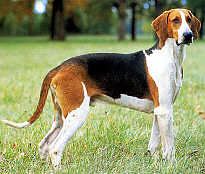
The Anglo-Français de Petite Vénerie is a medium-sized breed of dog used in hunting as a scenthound, usually in packs. It is one of the Anglo-French hound breeds which were created by crossing French scenthounds with English foxhounds. The name Petite Vénerie does not mean that dogs of the breed are petite or small, but rather that it is used to hunt small game.

The Southern Hound was a breed of dog that existed in Britain probably until sometime in the 19th century, now extinct. The exact date of its extinction is not known; it is likely that it was gradually interbred with other breeds until the genuine Southern Hound bloodline ceased to exist.

Anglo-Français and Français hounds are a general dog type of hunting dog that include ancient French hounds and breeds created by mixing the French dogs with English (Anglo) Foxhounds. There are seven dog breeds that are described as Anglo-Français and Français hounds.

The Sabueso Español or Spanish Hound is a scenthound breed with its origin in the far north of Iberian Peninsula. This breed has been used in this mountainous region since hundreds of years ago for all kind of game: wild boar, hare, brown bear, wolf, red deer, fox, roe deer and chamois. It is an exclusive working breed, employed in hunting with firearms.

The bloodhound is a large scent hound, originally bred for hunting deer, wild boar, rabbits, and since the Middle Ages, for tracking people. Believed to be descended from hounds once kept at the Abbey of Saint-Hubert, Belgium, in French it is called le chien de Saint-Hubert.

Wolf hunting with dogs is a method of wolf hunting which relies on the use of hunting dogs. While any dog, especially a hound used for hunting wolves may be loosely termed a "wolfhound", several dog breeds have been specifically bred for the purpose, some of which, such as the Irish Wolfhound, have the word in their breed name.

The sleuth hound was a breed of dog. Broadly, it was a Scottish term for what in England was called the Bloodhound, although it seems that there were slight differences between them. It was also referred to as a 'slough dog',, and a 'slow hound', the first word likely representing a mispronunciation of 'slough' rather than a reference to the speed of the hound.
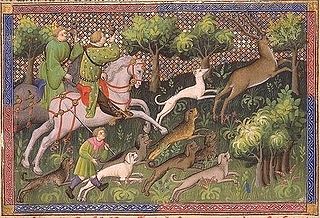
Rache, also spelled racch, rach, and ratch, from Old English ræcc, linked to Old Norse rakkí, is an obsolete name for a type of hunting dog used in Great Britain in the Middle Ages. It was a scenthound used in a pack to run down and kill game, or bring it to bay. The word appears before the Norman Conquest. It was sometimes confused with 'brache', which is a French derived word for a female scenthound.

A hart is a male red deer, synonymous with stag and used in contrast to the female hind; its use may now be considered mostly poetic or archaic. The word comes from Middle English hert, from Old English heorot; compare Frisian hart, Dutch hert, German Hirsch, and Swedish, Norwegian, and Danish hjort, all meaning "deer". Heorot is given as the name of Hrothgar's mead hall in the Old English epic Beowulf.
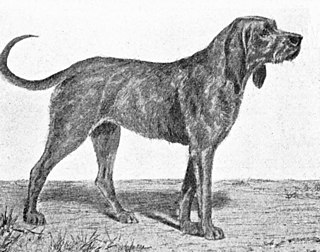
The Chien-gris a.k.a. Gris de Saint-Louis is an extinct breed of dog which originated in Medieval times. Like the Chien de Saint-Hubert, it was a scent hound, and formed part of the royal packs of France, which were composed, from about 1250 till 1470, exclusively of hounds of this type. According to King Charles IX, (1550–1574) they supposedly were introduced to France through Saint Louis, who had encountered these hounds while a prisoner during the Crusades, and subsequently received some as a gift. Old writers on hunting liked to ascribe an ancient and remote origin to their hounds, and these were claimed to be originally from Tartary. They were large, and, even though they did not have such good noses, were preferred by the Kings to the St Huberts, which were said to be only of medium size.

The Poitevin, also known as the Chien de Haut-Poitou, is a breed of French scenthound from the province of Poitou, this predominantly pack hound was created in the 17th century to hunt wolves.

Bassets are a sub-type of scenthound deliberately bred with short legs, that are used for hunting where the hunters accompany the hunting hounds on foot.






















